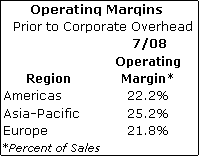IDEX Online Research: Tiffany Forges Ahead, Despite Economic Headwinds
October 13, 08
As it has so many times in the past, Tiffany & Company is using the economic slowdown – both in the U.S. and some global markets – as a springboard to growth when the inevitable recovery occurs. It is accelerating its worldwide expansion this year to 24 new units, accounting for a 13 percent increase. It also plans to open a new concept store of 2,000 square feet this Fall.
While the company’s sales have shown more moderate gains than during a period of strong economic growth, its pretax profit margin was up in the second fiscal quarter ended July 2008.
Even in this weak economy, Tiffany management is predicting that its global sales will rise by about 9 percent this year, and its operating margin will be up.
How does this company generate such strong gains in an otherwise weak period? First, it targets the upper end of the market, though not necessarily the top end; after all, Tiffany is an AGS jeweler, similar to the other 1,200 or so AGS jewelers in the U.S. Second, it has created an enviable brand, an opportunity that any jeweler has (but rarely pursues). Third, the company’s management knows how to leverage itself in both good and bad times. At any point in the economic cycle, Tiffany searches for opportunities.
The table below summarizes Tiffany’s second quarter results.

The following are highlights from the company’s second fiscal quarter ended July 2008.
- U.S. same-store sales fell by 4 percent in the quarter. While the New York Flagship store on Fifth Avenue posted a 5 percent sales increase, Tiffany branches around the U.S. generated a weak 6 percent same-store sales decline. The decline was relatively broad-based. However, second-tier markets were stronger than top tier markets. Demand in Florida and Las Vegas was weak. Sales in the Hawaii market were up due to demand from Japanese tourists. Overall, demand from U.S. customers was down in the U.S. market; demand from overseas customers shopping in the U.S. with their strong currency drive Tiffany’s U.S. sales during the quarter.
- The average ticket was up, but the number of transactions was down in the U.S. Demand was weakest in two price ranges: above $50,000 and below $500. Same-store sales were about the same in each of the three months of the quarter.
- The company’s strongest product categories during the quarter in the U.S. market were diamonds, engagement jewelry, studs, pendants, and diamonds by the yard. In addition, fashion jewelry was strong, and designer jewelry was up modestly. Statement jewelry showed a decline in demand.
- E-commerce and catalog sales declined by 4 percent due primarily to fewer orders. The average ticket rose modestly.
- The company’s “other” sales category includes three revenue sources: wholesale rough diamonds, Iridesse (pearl stores), and license revenues from Luxotica; these totaled $24.8 million in the second quarter. Wholesale diamond sales were up 41 percent to $21 million, year-over-year. License fees are just beginning to flow through the income statement, so most of the remaining $3.8 million came from Iridesse. On an annual basis, we’d guess Iridesse is still generating revenues below $20 million. That’s why we really don’t hear much about it; it is less than 1 percent of Tiffany’s annual 2007 sales of $2.9 billion.
- Tiffany’s sales in the Asia-Pacific region were solid – up 7 percent in constant dollars (this is the most comparable measure, when currency translation is a factor). Further, Europe’s sales were up a dramatic 29 percent, with same-store sales up 11 percent.
- Tiffany’s gross margin rose to 57.8 percent in the second fiscal quarter, up from last year’s 56.1 percent. Three factors drove the gross margin higher:
- Sales mix – Lower ticket goods tend to generate a higher gross margin.
- Sales leverage – Despite weak same-store sales in the U.S., strong sales in other global regions helped leverage relatively fixed costs for Tiffany.
- Higher retail prices – The company raised retail prices.
- The company’s operating expense ratio rose to 39.8 percent of sales from last year’s 39.1 percent due primarily to higher personnel and marketing costs.
- On a segment basis, the following table summarizes the company’s operating margins for the second quarter.

- Later this Fall, Tiffany plans to open its first 2,000 square foot concept store, the smallest footprint yet, for a “full service” store. The unit is planned for Glendale, California.
- Management’s outlook calls for total sales to be up about 9 percent this year. In the Americas region (U.S., Canada, and Central/South America), total sales are expected to rise by about 5 percent or so, with same-store sales flat for the year (but up modestly in the fourth quarter, due primarily to very easy comparisons). Further, we expect the company’s operating margin to rise modestly for the full year.